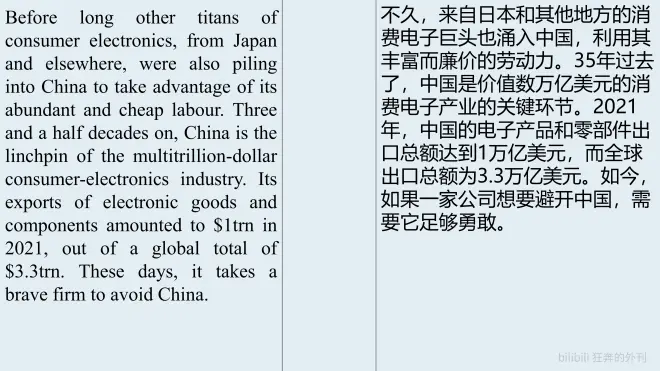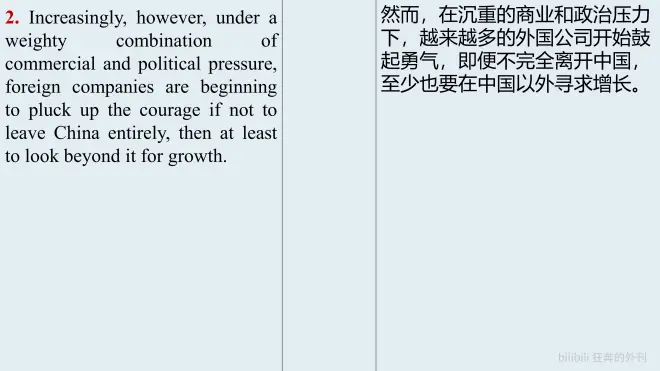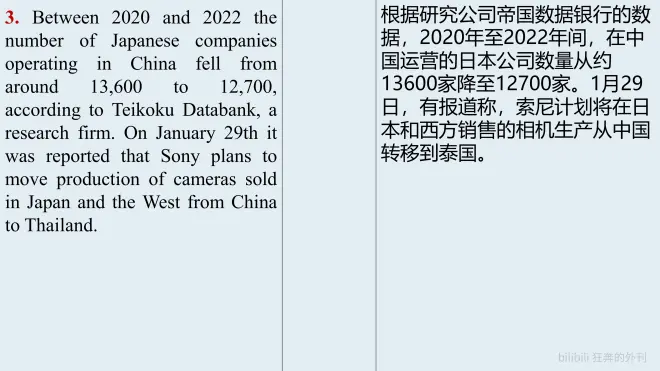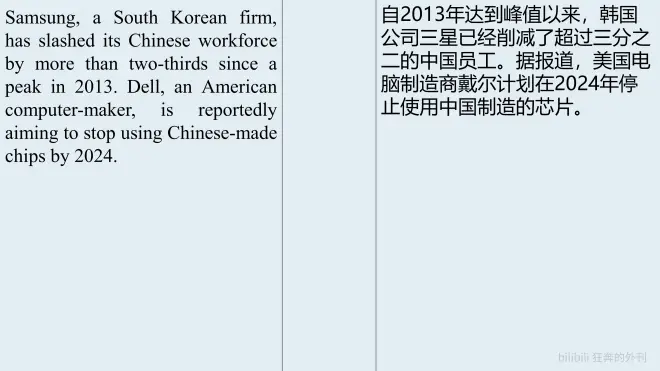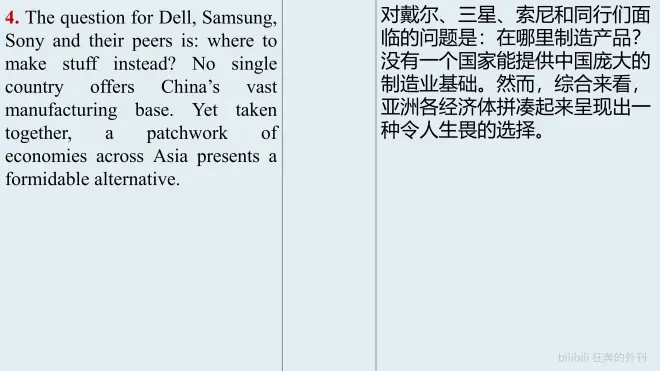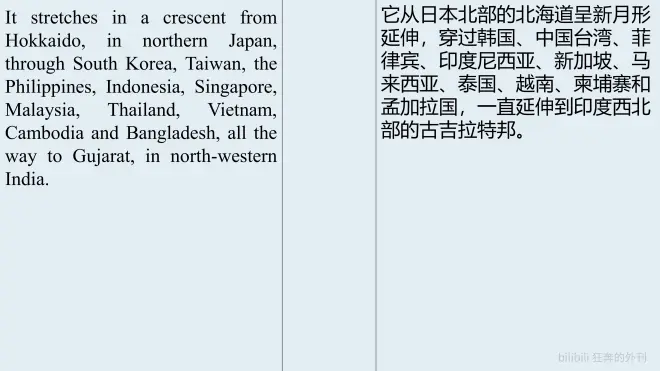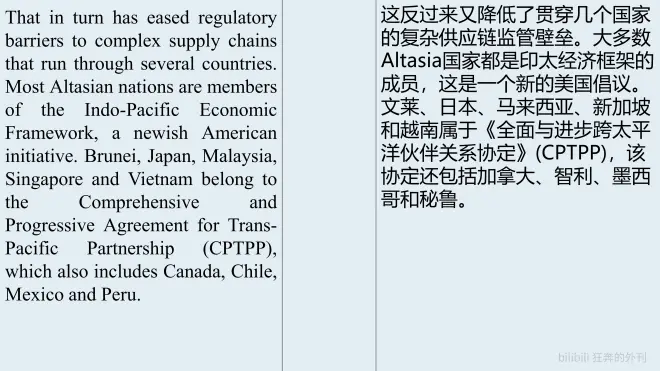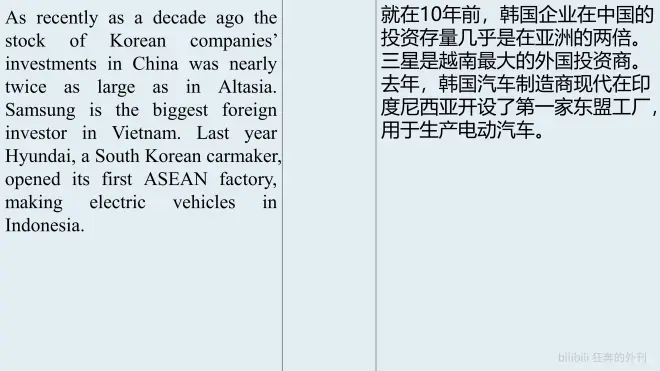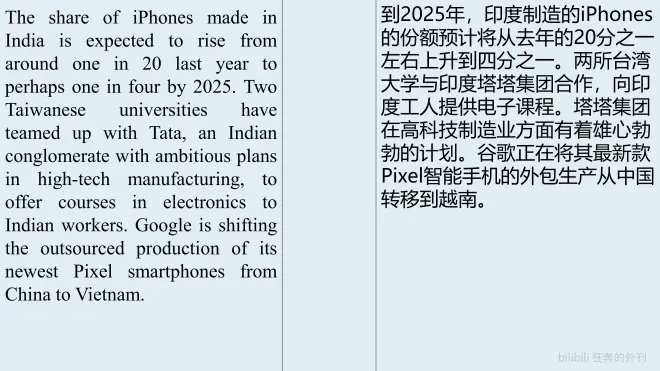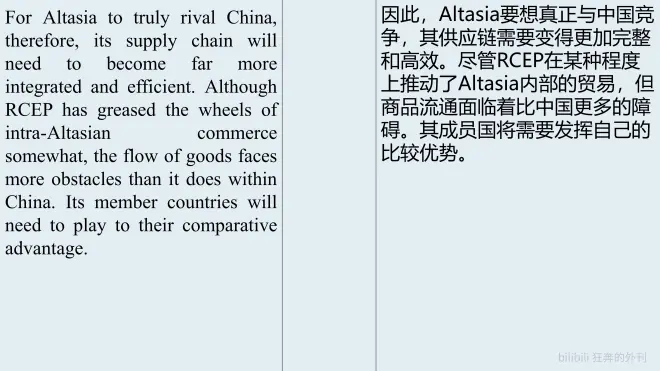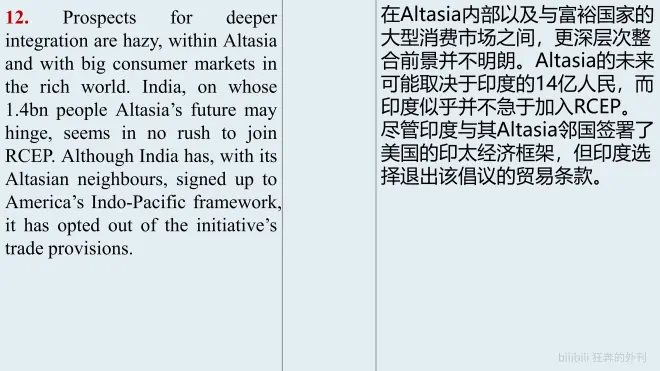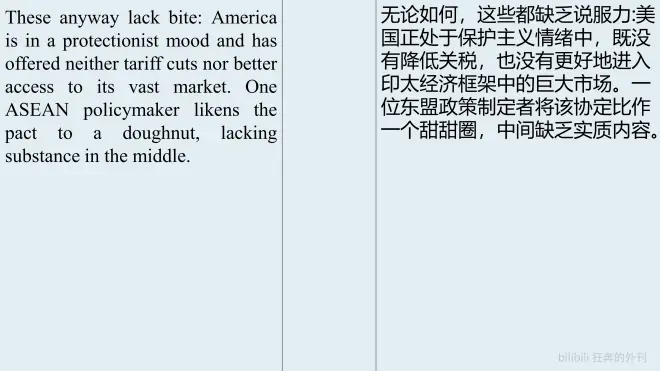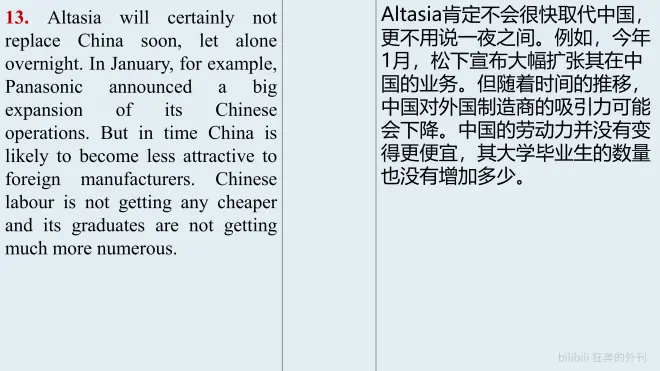外刊听读| 经济学人 亚洲国家挑战中国制造业

Global manufacturing
全球制造业
The Altasian option
亚洲替代选项
Can Asia’s alternative supply chain steal China’s thunder?
亚洲国家的替代供应链会抢中国的风头吗?
IN 1987 PANASONIC made an adventurous bet on China. At the time the electronics giant’s home country, Japan, was a global manufacturing powerhouse and the Chinese economy was no larger than Canada’s. So when the company entered a Chinese joint venture to make cathode-ray tubes for its televisions in Beijing, eyebrows were raised. Before long other titans of consumer electronics, from Japan and elsewhere, were also piling into China to take advantage of its abundant and cheap labour. Three and a half decades on, China is the linchpin of the multitrillion-dollar consumer-electronics industry. Its exports of electronic goods and components amounted to $1trn in 2021, out of a global total of $3.3trn. These days, it takes a brave firm to avoid China.
1987年,松下在中国进行了一次大胆的赌博。当时,这家电子巨头的祖国日本是全球制造业强国,而中国的经济规模比加拿大还小。因此,当松下进入一家中国合资企业,在北京为其电视机生产阴极射线管时,人们不禁为之侧目。不久,来自日本和其他地方的消费电子巨头也涌入中国,利用其丰富而廉价的劳动力。35年过去了,中国是价值数万亿美元的消费电子产业的关键环节。2021年,中国的电子产品和零部件出口总额达到1万亿美元,而全球出口总额为3.3万亿美元。如今,如果一家公司想要避开中国,需要它足够勇敢。
Increasingly, however, under a weighty combination of commercial and political pressure, foreign companies are beginning to pluck up the courage if not to leave China entirely, then at least to look beyond it for growth. Chinese labour is no longer that cheap: between 2013 and 2022 manufacturing wages doubled, to an average of $8.27 per hour (see chart). More important, the deepening Sino-American techno-decoupling is forcing manufacturers of high-tech products, especially those involving advanced semiconductors, to rethink their reliance on China.
然而,在沉重的商业和政治压力下,越来越多的外国公司开始鼓起勇气,即便不完全离开中国,至少也要在中国以外寻求增长。中国劳动力不再那么廉价:2013年至2022年间,制造业工资翻了一番,达到平均每小时8.27美元(见图表)。更重要的是,不断加深的中美技术脱钩正迫使高科技产品制造商,尤其是涉及先进半导体的制造商,重新考虑对中国的依赖。
Between 2020 and 2022 the number of Japanese companies operating in China fell from around 13,600 to 12,700, according to Teikoku Databank, a research firm. On January 29th it was reported that Sony plans to move production of cameras sold in Japan and the West from China to Thailand. Samsung, a South Korean firm, has slashed its Chinese workforce by more than two-thirds since a peak in 2013. Dell, an American computer-maker, is reportedly aiming to stop using Chinese-made chips by 2024.
根据研究公司帝国数据银行的数据,2020年至2022年间,在中国运营的日本公司数量从约13600家降至12700家。1月29日,有报道称,索尼计划将在日本和西方销售的相机生产从中国转移到泰国。自2013年达到峰值以来,韩国公司三星已经削减了超过三分之二的中国员工。据报道,美国电脑制造商戴尔计划在2024年停止使用中国制造的芯片。
The question for Dell, Samsung, Sony and their peers is: where to make stuff instead? No single country offers China’s vast manufacturing base. Yet taken together, a patchwork of economies across Asia presents a formidable alternative. It stretches in a crescent from Hokkaido, in northern Japan, through South Korea, Taiwan, the Philippines, Indonesia, Singapore, Malaysia, Thailand, Vietnam, Cambodia and Bangladesh, all the way to Gujarat, in north-western India. Its members have distinct strengths, from Japan’s high skills and deep pockets to India’s low wages. On paper, this is an opportunity for a useful division of labour, with some countries making sophisticated components and others assembling them into finished gadgets. Whether it can work in practice is a big test of the nascent geopolitical order.
对戴尔、三星、索尼和同行们面临的问题是:在哪里制造产品?没有一个国家能提供中国庞大的制造业基础。然而,综合来看,亚洲各经济体拼凑起来呈现出一种令人生畏的选择。它从日本北部的北海道呈新月形延伸,穿过韩国、中国台湾、菲律宾、印度尼西亚、新加坡、马来西亚、泰国、越南、柬埔寨和孟加拉国,一直延伸到印度西北部的古吉拉特邦。从日本的高科技和雄厚的财力到印度的低工资,其成员都有各自独特的优势。理论上,这是一个实现有效分工的机会,一些国家制造复杂的部件,另一些国家组装成成品。然而,它能否在实践中发挥作用,是对新生地缘政治秩序的一大考验。
This alternative Asian supply chain—call it Altasia—looks evenly matched with China in heft, or better. Its collective working-age population of 1.4bn dwarfs even China’s 950m. Altasia is home to 155m people aged between 25 and 54 with a tertiary education, compared with 145m in China —and, in contrast to ageing China, their ranks look poised to expand. In many parts of Altasia wages are considerably lower than in China: hourly manufacturing wages in India, Malaysia, the Philippines, Thailand and Vietnam are below $3, around one-third of what Chinese workers now demand. And the region is already an exporting power: its members sold $634bn-worth of merchandise to America in the 12 months to September 2022, edging out China’s $614bn.
这条替代性的亚洲供应链——称之为Altasia——看起来在分量上与中国旗鼓相当,甚至更胜一筹。其14亿劳动年龄人口的总和甚至让中国的9.5亿人口相形见绌。Altasia有1.55亿年龄在25岁至54岁之间、受过高等教育的人,而中国只有1.45亿人——并且,与老龄化的中国形成鲜明对比的是,这些适龄人口的数量看起来还会增加。Altasia许多地方的工资比中国低得多:印度、马来西亚、菲律宾、泰国和越南的制造业时薪低于3美元,大约是中国工人现在需求的三分之一。该地区已经是一个出口大国:在截至2022年9月的12个月里,其成员国向美国出售了价值6340亿美元的商品,超过了中国的6140亿美元。
Altasia has also become more economically integrated. All of it bar India, Bangladesh and Taiwan has, helpfully, signed on to the Regional Comprehensive Economic Partnership (RCEP, which also includes China). By harmonising the rules of origin across the region’s sundry existing trade deals, the pact has created a single market in intermediate products. That in turn has eased regulatory barriers to complex supply chains that run through several countries. Most Altasian nations are members of the Indo-Pacific Economic Framework, a newish American initiative. Brunei, Japan, Malaysia, Singapore and Vietnam belong to the Comprehensive and Progressive Agreement for Trans-Pacific Partnership (CPTPP), which also includes Canada, Chile, Mexico and Peru.
Altasia的经济也更加一体化。除了印度、孟加拉国和中国台湾之外,所有其他国家都签署了《区域全面经济伙伴关系协定》(RCEP,也包括中国)。通过协调该地区现有各种贸易协定的原产地规则,该协定创造了一个单一的中间产品市场。这反过来又降低了贯穿几个国家的复杂供应链监管壁垒。大多数Altasia国家都是印太经济框架的成员,这是一个新的美国倡议。文莱、日本、马来西亚、新加坡和越南属于《全面与进步跨太平洋伙伴关系协定》(CPTPP),该协定还包括加拿大、智利、墨西哥和秘鲁。
A model for the Altasian economy already exists, courtesy of Japanese companies, which have been building supply chains in South-East Asia for decades. More recently Japan’s rich Altasian neighbour, South Korea, has followed its example. In 2020 South Korean firms’ total stock of direct investments in Brunei, Cambodia, Indonesia, Laos, Malaysia, the Philippines, Singapore, Thailand and Vietnam—which together with unstable Myanmar make up the Association of South-East-Asian Nations (ASEAN)—and Bangladesh reached $96bn, narrowly outstripping Korean investments in China. As recently as a decade ago the stock of Korean companies’ investments in China was nearly twice as large as in Altasia. Samsung is the biggest foreign investor in Vietnam. Last year Hyundai, a South Korean carmaker, opened its first ASEAN factory, making electric vehicles in Indonesia.
得益于日本公司,Altasia经济的模式已经存在,这些公司已经在东南亚建立了几十年的供应链。最近,日本富裕的Altasia邻国韩国也加入其中。2020年,韩国企业在文莱、柬埔寨、印度尼西亚、老挝、马来西亚、菲律宾、新加坡、泰国和越南(加上政局不稳定的缅甸组成了东盟)以及孟加拉国的直接投资总额达到960亿美元,略微超过韩国在中国的投资。就在10年前,韩国企业在中国的投资存量几乎是在亚洲的两倍。三星是越南最大的外国投资商。去年,韩国汽车制造商现代在印度尼西亚开设了第一家东盟工厂,用于生产电动汽车。
For most a link
对于大多数国家来说,一种链接
Now more non-Altasian firms are eyeing the region, often via their Taiwanese contract manufacturers. Taiwan’s Foxconn, Pegatron and Wistron, which assemble gadgets for Apple, among others, are investing heavily in Indian factories. The share of iPhones made in India is expected to rise from around one in 20 last year to perhaps one in four by 2025. Two Taiwanese universities have teamed up with Tata, an Indian conglomerate with ambitious plans in high-tech manufacturing, to offer courses in electronics to Indian workers. Google is shifting the outsourced production of its newest Pixel smartphones from China to Vietnam.
现在,越来越多的非Altasia公司开始关注该地区,一般是通过与中国台湾的合同制造商。为苹果组装小配件的富士康、和硕联合科技和纬创资通等公司正在印度工厂大举投资。到2025年,印度制造的iPhones的份额预计将从去年的20分之一左右上升到四分之一。两所台湾大学与印度塔塔集团合作,向印度工人提供电子课程。塔塔集团在高科技制造业方面有着雄心勃勃的计划。谷歌正在将其最新款Pixel智能手机的外包生产从中国转移到越南。
More sophisticated manufacturing, especially of geopolitically fraught semiconductors, is also moving to Altasia. Malaysia already exports around 10% of the world’s chips by value, more than America. ASEAN countries account for more than a quarter of global exports of integrated circuits, easily surpassing China’s 18%. And that lead is growing. Qualcomm, an American “fabless” chipmaker, which sells microprocessor designs for others to manufacture, opened its first research-and-development centre in Vietnam in 2020. Qualcomm’s revenues from Vietnamese chip factories, many of which belong to global giants like Samsung, tripled between 2020 and 2022. Earlier this month the local government of Ho Chi Minh City announced that it was courting a $3.3bn investment from Intel (though it later struck the American chip giant’s name from the statement online).
更复杂的制造业,尤其是充满地缘政治因素的半导体制造业,也在向Altasia转移。按价值计算,马来西亚已经出口了全球10%的芯片,超过了美国。东盟国家占全球集成电路出口的四分之一以上,轻松超过中国的18%。这种领先优势正在扩大。美国“无实体工厂”的芯片制造商高通,销售微处理器设计方案给别人制造,于2020年在越南开设了第一个研发中心。高通从越南芯片工厂获得的收入在2020年至2022年间增长了两倍,其中许多工厂属于三星等全球巨头。本月早些时候,胡志明市地方政府宣布,它正在争取英特尔33亿美元的投资(尽管后来它从网上声明中删除了这家美国芯片巨头的名字)。
China’s huge advantage has historically been its vast single market, knit together with decent infrastructure, where value could be added without suppliers, workers and capital crossing national borders. For Altasia to truly rival China, therefore, its supply chain will need to become far more integrated and efficient. Although RCEP has greased the wheels of intra-Altasian commerce somewhat, the flow of goods faces more obstacles than it does within China. Its member countries will need to play to their comparative advantage.
从历史上看,中国的巨大优势一直是其庞大的单一市场与良好的基础设施紧密相连,在这里,供应商、工人和资本无需跨越国界就能实现增值。因此,Altasia要想真正与中国竞争,其供应链需要变得更加完整和高效。尽管RCEP在某种程度上推动了Altasia内部的贸易,但商品流通面临着比中国更多的障碍。其成员国将需要发挥自己的比较优势。
For now the infrastructure that connects them is shabby, at best. Finicky regulations and national ambitions can easily gum up the alternative supply chain. Altasia’s poorer countries are not necessarily keen on the logical division of labour, which would see them play a bigger role in the more menial parts of the electronics supply chain. And forgoing all Chinese-made parts is next to impossible. Thamlev, an American electric-bike startup, moved production from China to Malaysia in 2022 in order to avoid a 25% American tariff, but still needed to import Chinese components. As a result, it took a month longer for its e-bikes to reach American riders.
目前,连接它们的基础设施充其量也只是破旧不堪。过分严苛的法规和国家野心很容易搞乱如今的亚洲替代供应链。Altasia较贫穷的国家不一定热衷于合理的劳动分工,这将使它们在电子产品供应链中发挥更大的作用,尤其是在低报酬的一端。放弃所有中国制造的零件几乎是不可能的。美国电动车初创公司Thamlev在2022年将生产从中国转移到马来西亚,以避免25%的美国关税,但仍需要进口中国零部件。结果,美国骑手多等了一个月才拿到电动车。
Prospects for deeper integration are hazy, within Altasia and with big consumer markets in the rich world. India, on whose 1.4bn people Altasia’s future may hinge, seems in no rush to join RCEP. Although India has, with its Altasian neighbours, signed up to America’s Indo-Pacific framework, it has opted out of the initiative’s trade provisions. These anyway lack bite: America is in a protectionist mood and has offered neither tariff cuts nor better access to its vast market. One ASEAN policymaker likens the pact to a doughnut, lacking substance in the middle.
在Altasia内部以及与富裕国家的大型消费市场之间,更深层次整合前景并不明朗。Altasia的未来可能取决于印度的14亿人民,而印度似乎并不急于加入RCEP。尽管印度与其Altasia邻国签署了美国的印太经济框架,但印度选择退出该倡议的贸易条款。无论如何,这些都缺乏说服力:美国正处于保护主义情绪中,既没有降低关税,也没有更好地进入印太经济框架中的巨大市场。一位东盟政策制定者将该协定比作一个甜甜圈,中间缺乏实质内容。
Altasia will certainly not replace China soon, let alone overnight. In January, for example, Panasonic announced a big expansion of its Chinese operations. But in time China is likely to become less attractive to foreign manufacturers. Chinese labour is not getting any cheaper and its graduates are not getting much more numerous. America may yet realise that reducing its reliance on China in practice requires closer ties with friendly countries, including membership of the CPTPP, the precursor of which collapsed after America pulled out in 2017. And as a budding alternative to China, Altasia has no equal.
Altasia肯定不会很快取代中国,更不用说一夜之间。例如,今年1月,松下宣布大幅扩张其在中国的业务。但随着时间的推移,中国对外国制造商的吸引力可能会下降。中国的劳动力并没有变得更便宜,其大学毕业生的数量也没有增加多少。美国可能还没有意识到,在实践中减少对中国的依赖需要与友好国家建立更密切的关系,包括加入全面与进步跨太平洋伙伴关系协定(CPTPP),其前身在2017年美国退出后崩溃。作为中国的新兴替代者,Altasia无可匹敌。



